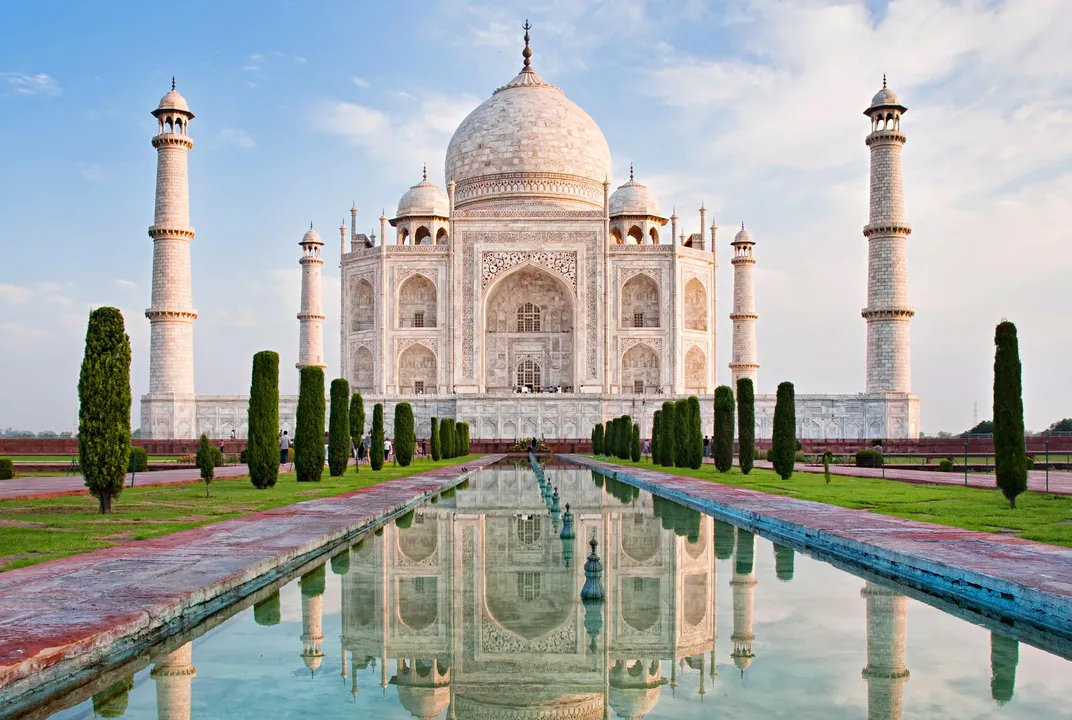To build the Taj Mahal, a scaffold of 500 wooden bricks was made. When the work was completed, Shah Jahan was told that it might take 5 years to demolish the scaffolding of bricks, and Shah Jahan ordered that all the bricks dropped It will happen to those labourers, now the result that the scaffolding which was built overnight was demolished.
It is a myth that the scaffolding was built to protect it from external threats before it was completely built. This story also has no merit. Once a man saw the Taj Mahal being built from outside a wall. His eyes were gouged out. Every guide to the Taj Mahal still tells that Shah Jahan cut off the hands of the builders so that they could not rebuild the eighth wonder of the world.
But so far no evidence of this incident has been received. Nor has any historian ever mentioned it. Inayat Khan was given the responsibility of carving the verses of the Quran on the Taj Mahal. Thus he was the only person whom Shah Jahan allowed to write his name on the Taj Mahal.
Apart from the Quranic verses, the carvings of flowers on the Taj Mahal were so tremendous that 200 years later a great historian of the same fort wrote that some of the flowers made on the walls of the Taj Mahal looked so real that hands automatically fell to touch them. He is not real. 40 different gems went into the building of the Taj Mahal. Shahjahan had imported it from different parts of Asia and Michael Prashn writes that the green-coloured stone was specially brought from China. The blue-coloured stone was imported from the mines of Afghanistan. They were told again when Firoza was brought from Tibet. While Mungo was sourced from the Green and Red Seas. Yellow Amber was brought from Upper Verma and Malik from Sri Lanka. Garlic stone was imported from the Nile Valley in Egypt. Sapphire was considered inauspicious to use in this work, so it was rarely procured and it was also used in very small quantities.
Historian Abdul Hameed Lahori, in his book Shahnama, in the History of Shahjahan, has told the price of the palace as ₹ 5000000, but other historians have said that the price was only equal to the wages paid to the labourers and did not include the cost of the goods used in this building. After the evidence found later, some historians have told the cost of construction of the Taj Mahal at 40000000 rupees, all the money for the construction of the building of Taj Mahal was taken from the government treasury and the treasury of the province of Agra.
For the maintenance of the Taj Mahal in the future, Shah Jahan had ordered that revenue from 30 villages around Agra would be used for this work. When Shah Jahan was dethroned by his son Aurangzeb in 1659, he Fell ill after a few days when he felt that he did not have much time left.
Then he expressed his wish to go up to the balcony of the Taj Mahal from where he could see the Taj Mahal built by him at all times.
Wrapped up, Shah Jahan said goodbye to this world on 21 January 1666. At that time his daughter Jahanara was with him. His body was laid in a casket made of beautiful wood. His daughter wanted him to be cremated in a royal manner but immediately Aurangzeb did not respect her daughter’s request. was buried next to.
After the fall of the Mughals, the British captured Agra in 1803 AD, after which the precious gems, carpets and wall hangings inlaid in the walls of the Taj Mahal disappeared. The British had taken the mosque located in the Taj Mahal on rent. And built honeymoon cottages around it. Military bands were playing on the platform of the mausoleum and picnic parties were taking place in the garden of the Taj Mahal. During this or rumour also arose that in 1830 the British Governor General Governor Lord William Batting thought of auctioning the marble of the Taj Mahal. During the rebellion of 1857 British troops damaged some of the Mughal buildings.
One of them was the palace of Asif Khan, father of Mumtaz Mahal, but the Taj Mahal was saved. At the beginning of the 20th century, the British Viceroy Lord Curzon showed great interest in repairing the Taj Mahal. Anticipating an attack, the Government of India sewed a giant black coloured cloth to cover the Taj Mahal so that it could not be seen from above in the moonlight at night, this cloth remained safe till the year 1995 but when the rats bitten it from place to place. Then that cloth was destroyed. Since then, the Government of India stopped the special security agencies of the Taj Mahal and opened it for tourists, due to which people from abroad come to see the Taj Mahal and visit India.
conclusion
Shah Jahan, the Mughal emperor of India, commissioned the construction of the Taj Mahal as a mausoleum for his beloved wife, Mumtaz Mahal. The construction of the Taj Mahal took place between 1632 and 1653, and it involved the labour of thousands of skilled artisans, architects, and craftsmen.
Shah Jahan, deeply saddened by the death of Mumtaz Mahal during childbirth, envisioned a magnificent monument to honour her memory. He entrusted the project to a team of architects, led by Ustad Ahmad Lahauri, who was the chief architect of the Mughal Empire.
The construction of the Taj Mahal was a massive undertaking that required extensive resources and manpower. The emperor employed thousands of skilled workers, including architects, masons, craftsmen, and labourers. The materials used in the construction were brought from various parts of India and neighbouring countries. Precious stones, including marble, were sourced from Rajasthan, jasper from Punjab, turquoise from Tibet, and sapphires from Sri Lanka, to name a few.
Shah Jahan closely supervised the construction process and provided the necessary resources to ensure the timely completion of the project. He employed the finest craftsmen and artisans, who adorned the Taj Mahal with intricate carvings, calligraphy, and exquisite inlay work using semi-precious stones.
The Taj Mahal’s construction was a significant undertaking, requiring meticulous planning and execution. It stands as a testament to the architectural and artistic brilliance of the Mughal Empire and remains one of the most iconic and recognized structures in the world today.







Pingback: How did Shah Jahan get the Taj Mahal of Agra built? Part-1 - Morning Magazines